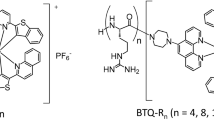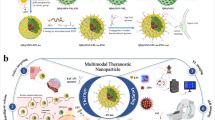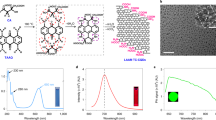Abstract
To take full advantage of the unique optical properties of quantum dots (QDs) and expedite future near-infrared fluorescence (NIRF) imaging applications, QDs need to be effectively, specifically and reliably directed to a specific organ or disease site after systemic administration. Recently, we reported the use of peptide-conjugated QDs for non-invasive NIRF imaging of tumor vasculature markers in small animal models. In this protocol, we describe the detailed procedure for the preparation of such peptide-conjugated QDs using commercially available PEG-coated QDs and arginine-glycine-aspartic acid (RGD) peptides. Conjugation of the thiolated RGD peptide to the QDs was achieved through a heterobifunctional linker, 4-maleimidobutyric acid N-succinimidyl ester. Competitive cell binding assay, using 125I-echistatin as the radioligand, and live cell staining were carried out to confirm the successful attachment of the RGD peptides to the QD surface before in vivo imaging of tumor-bearing mice. In general, QD conjugation and in vitro validation of the peptide-conjugated QDs can be accomplished within 1–2 d; in vivo imaging will take another 1–2 d depending on the experimental design.
This is a preview of subscription content, access via your institution
Access options
Subscribe to this journal
Receive 12 print issues and online access
$259.00 per year
only $21.58 per issue
Buy this article
- Purchase on Springer Link
- Instant access to full article PDF
Prices may be subject to local taxes which are calculated during checkout





Similar content being viewed by others
References
Cai, W., Hsu, A.R., Li, Z.B. & Chen, X. Are quantum dots ready for in vivo imaging in human subjects? Nanoscale Res. Lett. 2, 265–281 (2007).
Michalet, X. et al. Quantum dots for live cells, in vivo imaging, and diagnostics. Science 307, 538–544 (2005).
Medintz, I.L., Uyeda, H.T., Goldman, E.R. & Mattoussi, H. Quantum dot bioconjugates for imaging, labelling and sensing. Nat. Mater. 4, 435–446 (2005).
Alivisatos, A.P., Gu, W. & Larabell, C. Quantum dots as cellular probes. Annu. Rev. Biomed. Eng. 7, 55–76 (2005).
Li, Z.B., Cai, W. & Chen, X. Semiconductor quantum dots for in vivo imaging. J. Nanosci. Nanotechnol. 7, 2567–2581 (2007).
Frangioni, J.V. In vivo near-infrared fluorescence imaging. Curr. Opin. Chem. Biol. 7, 626–634 (2003).
Dubertret, B. et al. In vivo imaging of quantum dots encapsulated in phospholipid micelles. Science 298, 1759–1762 (2002).
Voura, E.B., Jaiswal, J.K., Mattoussi, H. & Simon, S.M. Tracking metastatic tumor cell extravasation with quantum dot nanocrystals and fluorescence emission-scanning microscopy. Nat. Med. 10, 993–998 (2004).
Larson, D.R. et al. Water-soluble quantum dots for multiphoton fluorescence imaging in vivo. Science 300, 1434–1436 (2003).
Stroh, M. et al. Quantum dots spectrally distinguish multiple species within the tumor milieu in vivo. Nat. Med. 11, 678–682 (2005).
Kim, S. et al. Near-infrared fluorescent type II quantum dots for sentinel lymph node mapping. Nat. Biotechnol. 22, 93–97 (2004).
Zimmer, J.P. et al. Size series of small indium arsenide-zinc selenide core-shell nanocrystals and their application to in vivo imaging. J. Am. Chem. Soc. 128, 2526–2527 (2006).
Thorne, R.G. & Nicholson, C. In vivo diffusion analysis with quantum dots and dextrans predicts the width of brain extracellular space. Proc. Natl. Acad. Sci. USA 103, 5567–5572 (2006).
Mammen, M., Chio, S. & Whitesides, G.M. Polyvalent interactions in biological systems: implications for design and use of multivalent ligands and inhibitors. Angew. Chem. Int. Ed. Engl. 37, 2755–2794 (1998).
Cai, W. & Chen, X. Anti-angiogenic cancer therapy based on integrin αvβ3 antagonism. Anti-Cancer Agents Med. Chem. 6, 407–428 (2006).
Cai, W., Rao, J., Gambhir, S.S. & Chen, X. How molecular imaging is speeding up anti-angiogenic drug development. Mol. Cancer Ther. 5, 2624–2633 (2006).
Bergers, G. & Benjamin, L.E. Tumorigenesis and the angiogenic switch. Nat. Rev. Cancer 3, 401–410 (2003).
Hood, J.D. & Cheresh, D.A. Role of integrins in cell invasion and migration. Nat. Rev. Cancer 2, 91–100 (2002).
Hynes, R.O. Integrins: bidirectional, allosteric signaling machines. Cell 110, 673–687 (2002).
Cai, W. et al. Peptide-labeled near-infrared quantum dots for imaging tumor vasculature in living subjects. Nano Lett. 6, 669–676 (2006).
Hermanson, G.T. Bioconjugate Techniques (Academic Press, San Diego, CA, USA, 1996).
Cai, W. et al. In vitro and in vivo characterization of 64Cu-labeled Abegrin, a humanized monoclonal antibody against integrin αvβ3 . Cancer Res. 66, 9673–9681 (2006).
Liu, Z. et al. In vivo biodistribution and highly efficient tumour targeting of carbon nanotubes in mice. Nat. Nanotechnol. 2, 47–52 (2007).
Cao, Q. et al. Combination of integrin siRNA and irradiation for breast cancer therapy. Biochem. Biophys. Res. Commun. 351, 726–732 (2006).
Pradhan, N., Battaglia, D.M., Liu, Y. & Peng, X. Efficient, stable, small, and water-soluble doped ZnSe nanocrystal emitters as non-cadmium biomedical labels. Nano Lett. 7, 312–317 (2007).
Pradhan, N. & Peng, X. Efficient and color-tunable Mn-doped ZnSe nanocrystal emitters: control of optical performance via greener synthetic chemistry. J. Am. Chem. Soc. 129, 3339–3347 (2007).
So, M.K., Xu, C., Loening, A.M., Gambhir, S.S. & Rao, J. Self-illuminating quantum dot conjugates for in vivo imaging. Nat. Biotechnol. 24, 339–343 (2006).
So, M.K., Loening, A.M., Gambhir, S.S. & Rao, J. Creating self-illuminating quantum dot conjugates. Nat. Protoc. 1, 1160–1164 (2006).
Mulder, W.J. et al. Quantum dots with a paramagnetic coating as a bimodal molecular imaging probe. Nano Lett. 6, 1–6 (2006).
Cai, W., Chen, K., Li, Z.B., Gambhir, S.S. & Chen, X. Dual-function probe for PET and near-infrared fluorescence imaging of tumor vasculature. J. Nucl. Med. 48, 1862–1870 (2007).
Cai, W. et al. Quantitative PET of EGFR expression in xenograft-bearing mice using 64Cu-labeled cetuximab, a chimeric anti-EGFR monoclonal antibody. Eur. J. Nucl. Med. Mol Imaging. 34, 850–858 (2007).
Cai, W. et al. PET of vascular endothelial growth factor receptor expression. J. Nucl. Med. 47, 2048–2056 (2006).
Levenson, R.M. Spectral imaging and pathology: seeing more. Lab. Med. 35, 244–251 (2004).
Mansfield, J.R., Gossage, K.W., Hoyt, C.C. & Levenson, R.M. Autofluorescence removal, multiplexing, and automated analysis methods for in-vivo fluorescence imaging. J. Biomed. Opt. 10, 41207 (2005).
Xiong, J.P. et al. Crystal structure of the extracellular segment of integrin αvβ3 . Science 294, 339–345 (2001).
Xiong, J.P. et al. Crystal structure of the extracellular segment of integrin αvβ3 in complex with an Arg-Gly-Asp ligand. Science 296, 151–155 (2002).
Cai, W., Zhang, X., Wu, Y. & Chen, X. A thiol-reactive 18F-labeling agent, N-[2-(4-18F-fluorobenzamido)ethyl]maleimide (18F-FBEM), and the synthesis of RGD peptide-based tracer for PET imaging of αvβ3 integrin expression. J. Nucl. Med. 47, 1172–1180 (2006).
Jue, R., Lambert, J.M., Pierce, L.R. & Traut, R.R. Addition of sulfhydryl groups to Escherichia coli ribosomes by protein modification with 2-iminothiolane (methyl 4-mercaptobutyrimidate). Biochemistry 17, 5399–5406 (1978).
Acknowledgements
This work was supported by the National Cancer Institute (NCI) Center of Cancer Nanotechnology Excellence (CCNE) grant U54CA119367 and R21 CA121842.
Author information
Authors and Affiliations
Contributions
W.C. and X.C. did the conjugation. W.C. did the imaging experiments and analyzed the data. W.C. and X.C. designed and carried out research. W.C. and X.C. wrote the manuscript.
Corresponding author
Rights and permissions
About this article
Cite this article
Cai, W., Chen, X. Preparation of peptide-conjugated quantum dots for tumor vasculature-targeted imaging. Nat Protoc 3, 89–96 (2008). https://doi.org/10.1038/nprot.2007.478
Published:
Issue Date:
DOI: https://doi.org/10.1038/nprot.2007.478
This article is cited by
-
Bioconjugates of photon-upconversion nanoparticles for cancer biomarker detection and imaging
Nature Protocols (2022)
-
Fluorescent Nanoparticles Coated with a Somatostatin Analogue Target Blood Monocyte for Efficient Leukaemia Treatment
Pharmaceutical Research (2020)
-
Antibiotic-loaded nanoparticles targeted to the site of infection enhance antibacterial efficacy
Nature Biomedical Engineering (2018)
Comments
By submitting a comment you agree to abide by our Terms and Community Guidelines. If you find something abusive or that does not comply with our terms or guidelines please flag it as inappropriate.



